Don’t worry, we get it — you love lifting weights, and the idea of parting with your favorite barbell or dumbbell exercises might make your skin crawl. But a good bodyweight workout can come in handy in more ways than you might think.
BarBend may be all about clanging and banging some heavy weights, but our editorial staff is packed to the brim with experts on everything exercise — including bodyweight training and how to optimize it to meet your goals.
Here are 15 of our expert-verified picks for the best bodyweight exercises for beginners, advanced athletes, and everyone in between.
Recent Updates: On Apr. 16, 2024, BarBend Senior Writer Jake Dickson updated this article to better utilize the existing exercises and incorporate them into user-friendly workout content. Read more about BarBend‘s process for exercise and workout prescriptions here.
15 Best Bodyweight Exercises
- Push-Up
- Squat
- Inverted Row
- Chin-Up
- Glute Bridge
- Bear Crawl
- Mountain Climbers
- Burpee
- Triceps Dip
- Pull-Up
- Plank
- Wall Walk
- Broad Jump
- Lunge
- Step-Up
1. Push-Up
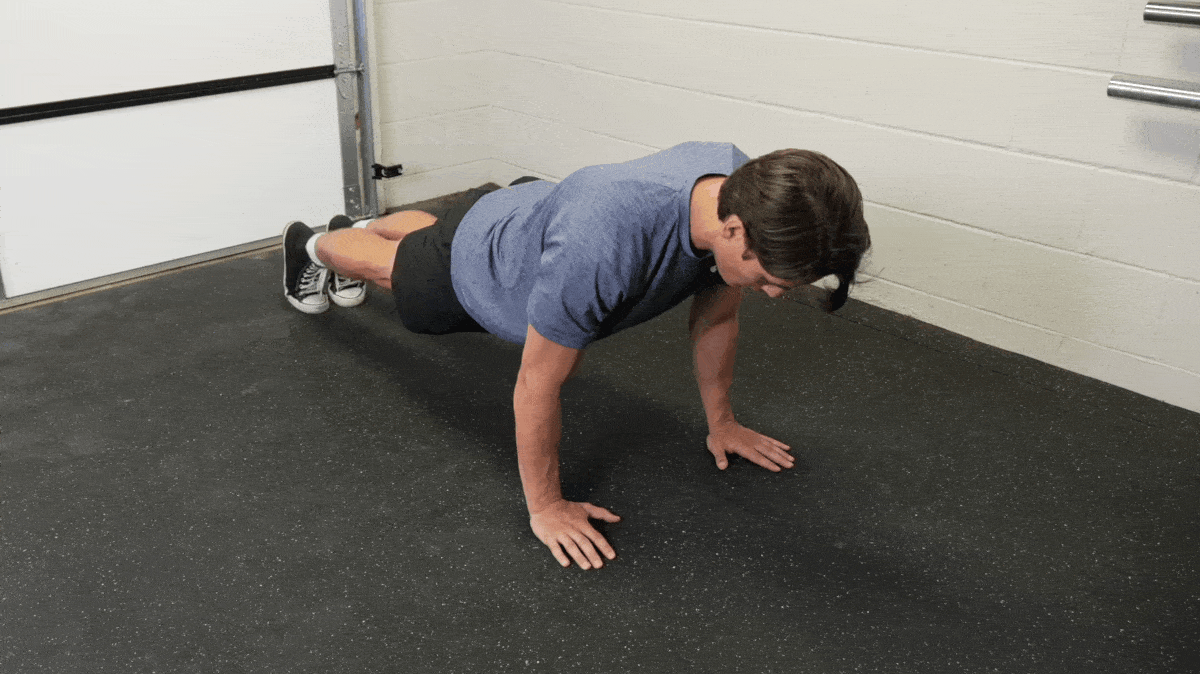
The push-up is one of the most basic and effective moves for improving upper body strength. And it really couldn’t be easier to do. You get on all fours, keep your back straight, and repeatedly lower yourself down and up — working the chest, triceps, and shoulders. Your core will also benefit, as the push-up is a moving plank that stabilizes your entire body.
[Read More: A One Month Push-Up Training Program for Beginners (3 Days Per Week)]
The push-up is an exercise you can do anywhere with no equipment. It activates your core from front to back and strengthens your entire torso in the process.
How To Do It
- Get into a plank position with your feet together and hands underneath your shoulders.
- Keep the abs tight and your butt just slightly up.
- Lower yourself under control until your chest is about an inch from the floor.
- Hold for a beat, and then drive yourself back up.
Modifications
- Make It Easier: Do push-ups on your knees rather than with straight legs.
- Make It Harder: Put a weight plate or similar heavy object on your back.
2. Squat
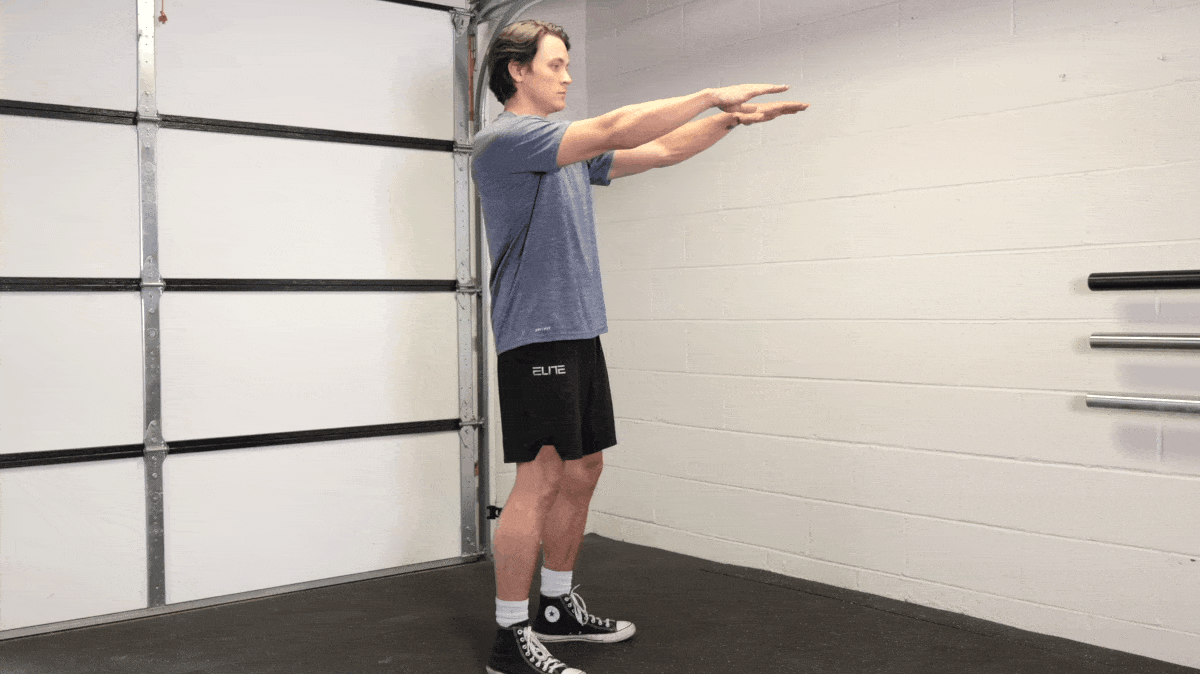
The squat is regarded as one of the best movements — loaded or unloaded — for improving mobility and taxing your legs. Some even refer to the squat as the king of all lifts. You should be squatting if you want to sprint faster, jump higher, lift heavier, and look better.
[Read More: The Science-Backed Benefits of Squats You Should Know About]
You’ll improve mobility as the squat has your body move through multiple planes of motion to complete the exercise. Moreover, you stand to gain more leg muscle as the squat targets your glutes, quads, hamstrings, calves, and hip flexors.
How To Do It
- Stand tall with your feet in a comfortable stance. The width and toe angle is entirely individual, so take time to find out what your body feels best doing.
- Extend your arms in front of your torso as a counterweight, then slowly sit your pelvis downwards.
- Sink as deep as possible while keeping a straight back before standing back up.
Modifications
- Make It Easier: Place your heels on a 1-2” elevation to make it easier to squat.
- Make It Harder: Try doing single-leg bodyweight squats.
3. Inverted Row
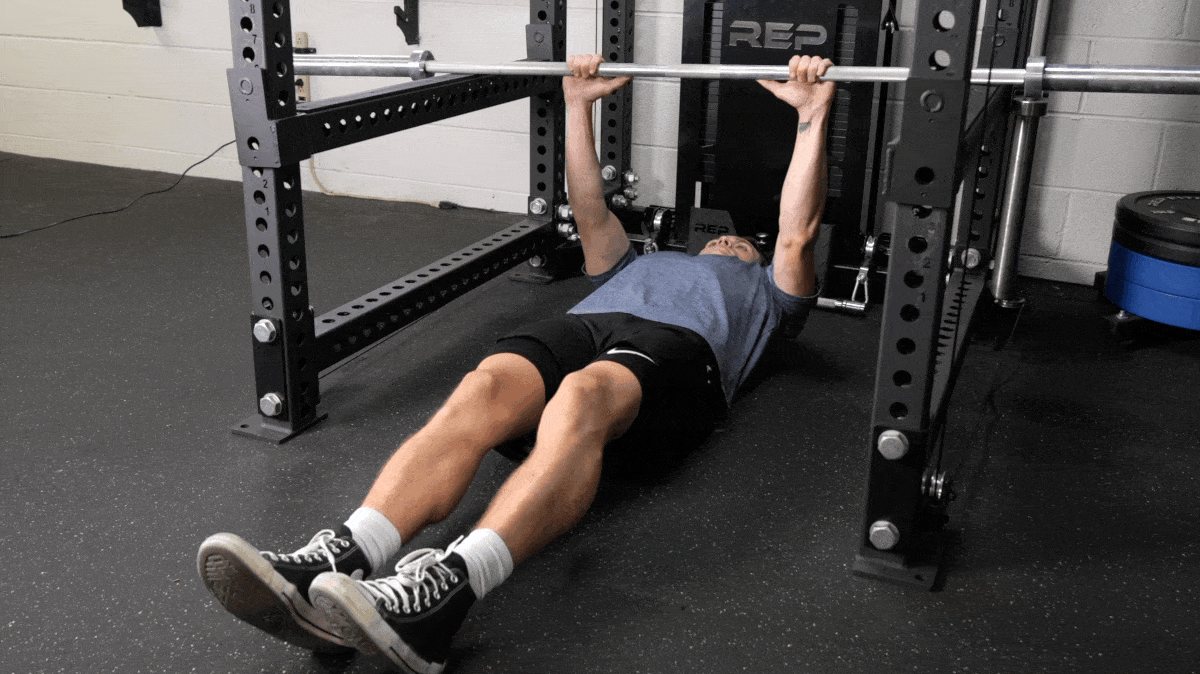
Think of an inverted row as pull-up lite. You’re pulling less of your body weight, so it’s easier to do for beginners while virtually recruiting the same muscles as a pull-up. The inverted row is technically a horizontal rowing movement, as your body is parallel to the floor, making it comparable to cable rows.
[Read More: The Best Upper Back Exercises For Strength, Size, and Posture]
That said, it’s a lower impact than both of those moves since you’re not using weight to stress your muscles but are instead fighting gravity. Advanced trainees can bust out many reps to further tax their backs.
How To Do It
- Lay a barbell into the hooks of a power rack, and set a few feet off the ground.
- Lay under the bar so the barbell is over the chest.
- Extend your arms up and grab the bar.
- Squeeze your shoulder blades together and row your chest to the bar or as close as possible.
Modifications
- Make It Easier: The more upright your torso is, the easier the move will be.
- Make It Harder: Place a weight plate in your lap.
4. Chin-Up
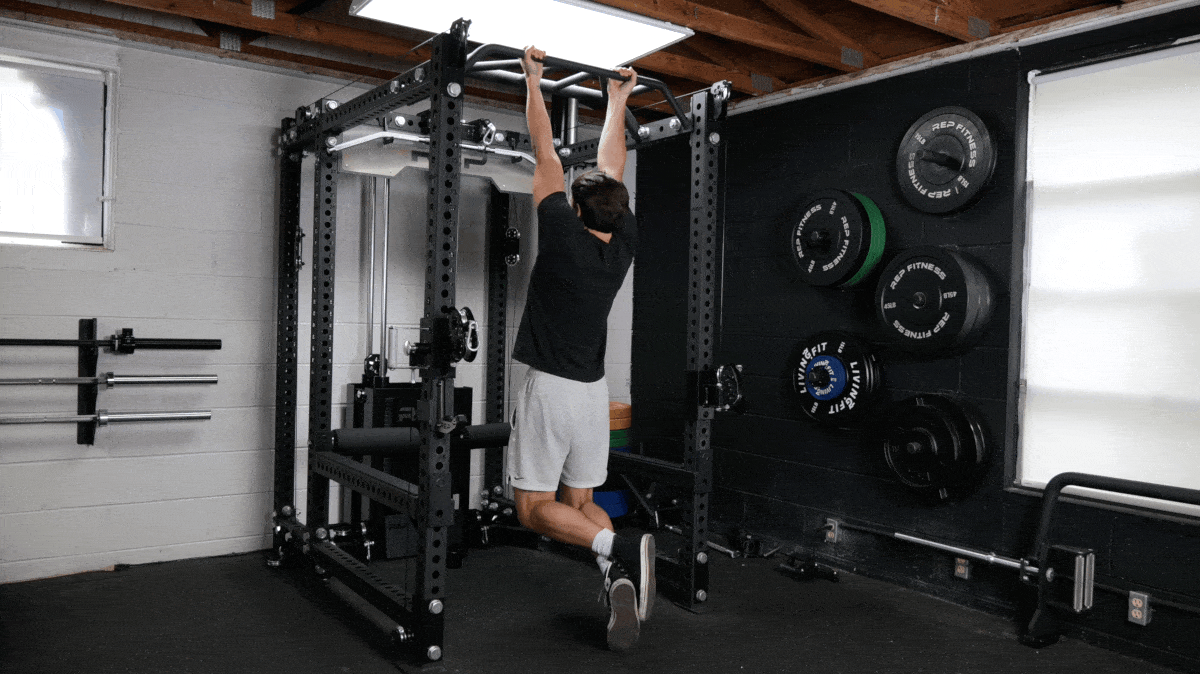
This pull-up variant has you supinate the hands (turn them inward) when pulling your chin to the bar. Like a pull-up, the chin-up recruits the back muscles — the lats, rhomboids, and traps — but with more emphasis on the biceps. Because of the extra bodyweight biceps exercise, most people are generally stronger in this position and can pump out a few extra reps.
The chin-up teaches you to control your entire bodyweight, build a stronger (and broader) back, and even throws in some “free” biceps training as well. Economically, pull-up (or chin-up) bars are quite affordable for your home gym. But you can also get them done just about anywhere that has a stable surface to hang from.
How To Do It
- Hang from a pull-up bar with your palms facing towards you, set about shoulder-width apart.
- Squeeze your shoulder blades together and pull up until your chin is at or above the bar.
Modifications
- Make It Easier: Try jumping chin-ups and resisting the negative portion.
- Make It Harder: Add a pause at both the bottom and top of each rep.
5. Glute Bridge
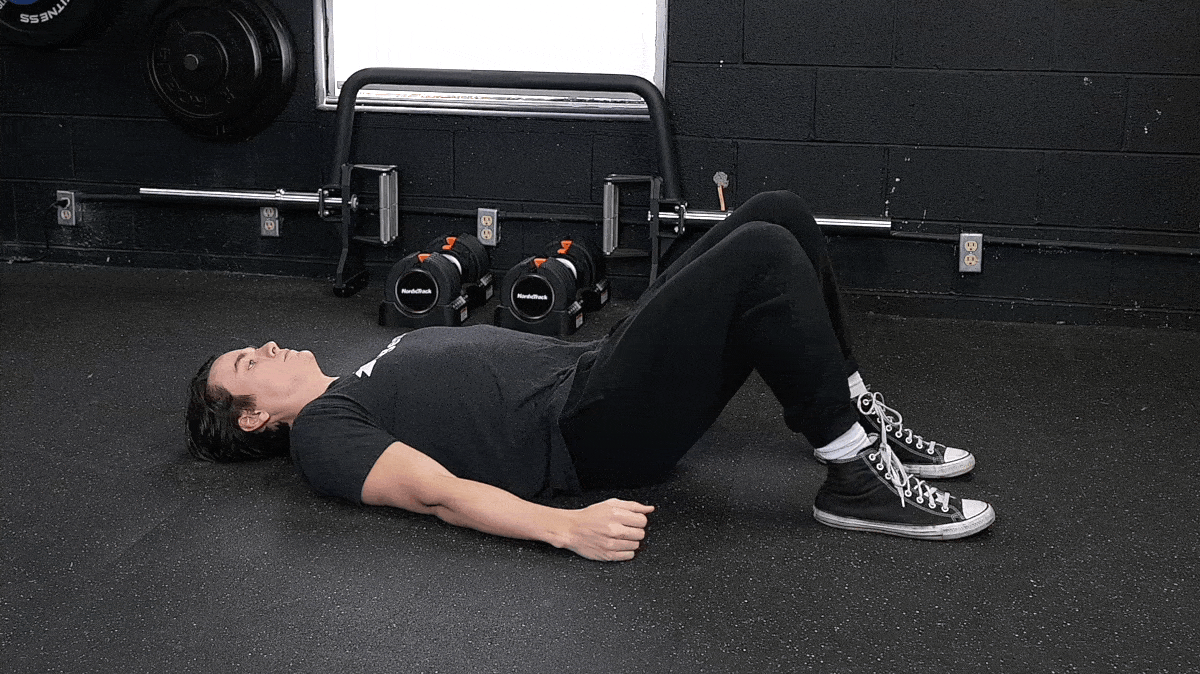
This exercise is popular among trainers to target the glutes while reducing potential back or knee pain. You can also load the glute bridge to increase your glute strength, which will carry over to your squat and deadlift, or perform sets of them unweighted as a warm-up.
The glute bridge allows you to train your glutes without directly loading your spine. Other benefits include substantial carryover to your squat or deadlift performance, without overly taxing your hamstrings in the process.
How To Do It
- Lie on the floor with your heels planted firmly on the ground.
- Contract the core and pull the belly button and ribs into the body.
- Drive through your heels to lift the hips and lower back off the floor until your torso and legs form a straight line.
Modifications
- Make It Easier: Place your hands on the ground next to you to help your balance.
- Make It Harder: Try it one leg at a time.
6. Bear Crawl
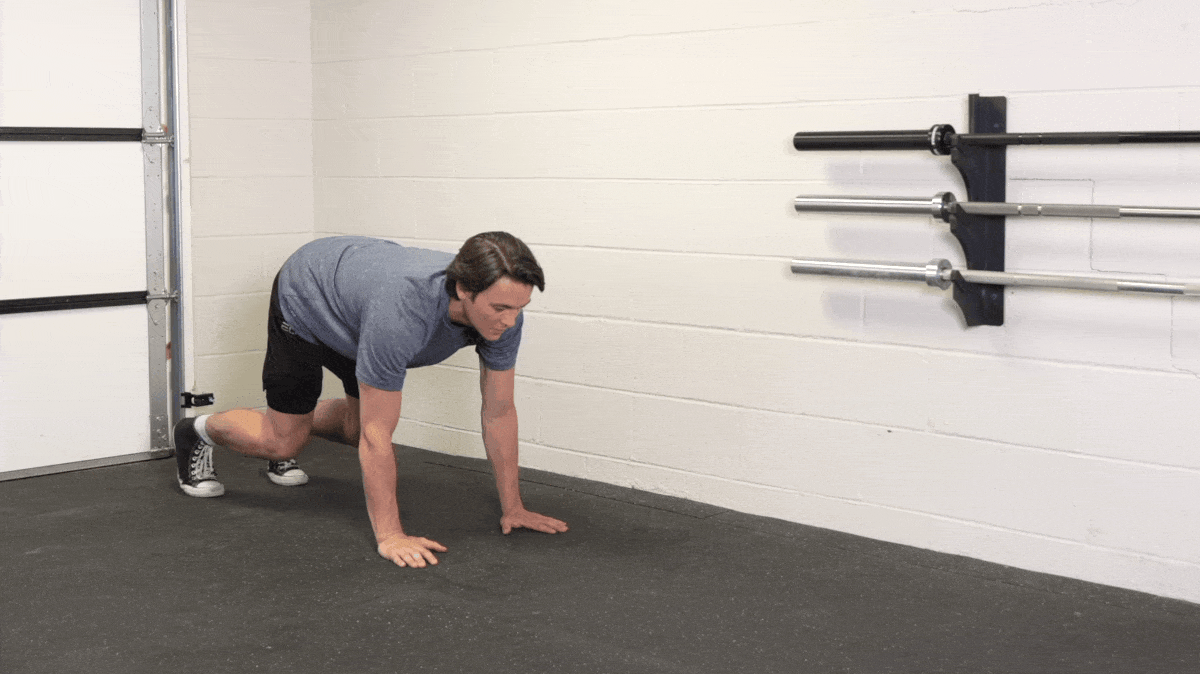
Crawling isn’t just for babies. By getting on all fours and slowly crawling forward — keeping your back straight and your knees under your hips and an inch off the floor — you’re teaching the body how to move as one unit. Your core will burn from stabilizing the torso, your quads will engage from propelling your feet forward, and your shoulders will work hard to move your arms.
[Read More: The Best Full-Body Bodybuilding Workout for Beginner to Advanced Lifters]
Crawling forward one leg at a time will improve your coordination, and you stand (or crawl, that is) to gain some extra range of motion in your shoulder, hip, and ankles as well.
How To Do It
- Get on all fours, with your hands underneath your shoulders and your knees directly underneath your hips.
- Now, raise the knees an inch off of the ground.
- Keeping your back straight, simultaneously move your right hand and left foot forward a few inches.
- Then, repeat on the other side. Keep repeating to crawl on.
Modifications
- Make It Easier: Try a motionless bear plank before adding movement.
- Make It Harder: Wear a weighted vest for extra resistance.
7. Mountain Climbers
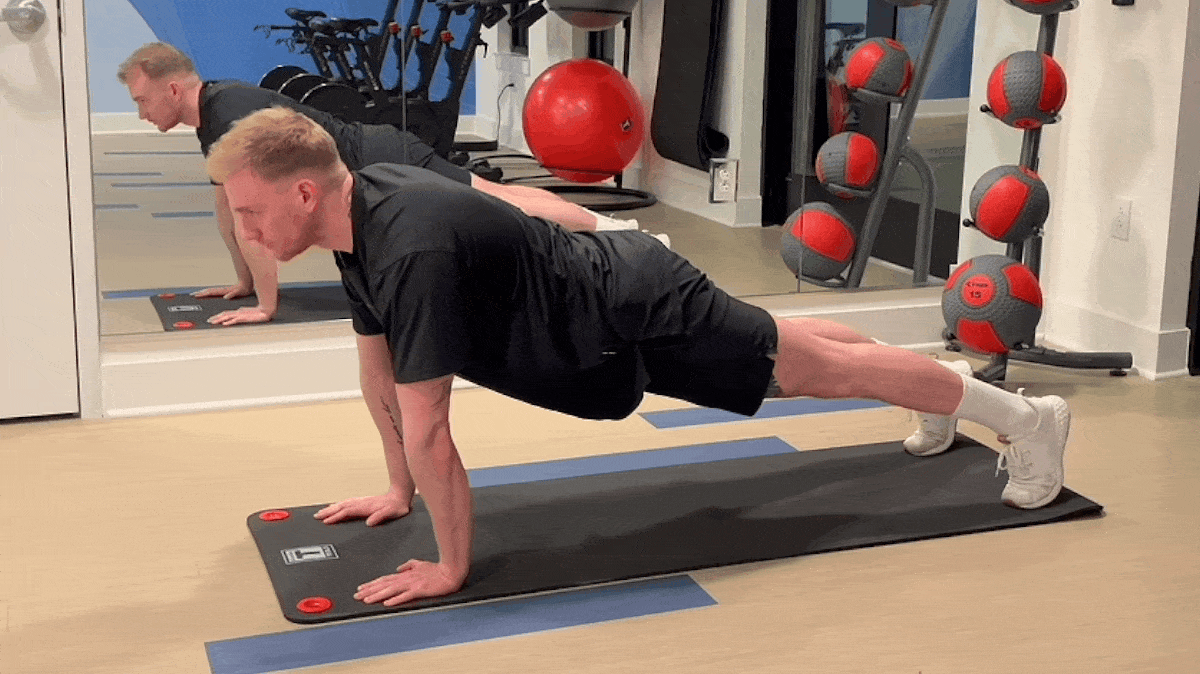
How To Do It
- Start in a push-up position with your elbows and knees locked out.
- Bring one leg up towards your chest by bending your knee and flexing your hip.
- The moment you place that foot on the ground under your torso, rapidly kick that leg back to the original position, bringing the opposite leg up at the same time.
- Alternate kicking each leg.
Modifications
- Make It Easier: Slow down your pace and deliberately move one leg back and forward at a time.
- Make It Harder: Try it with ankle weights.
8. Burpee
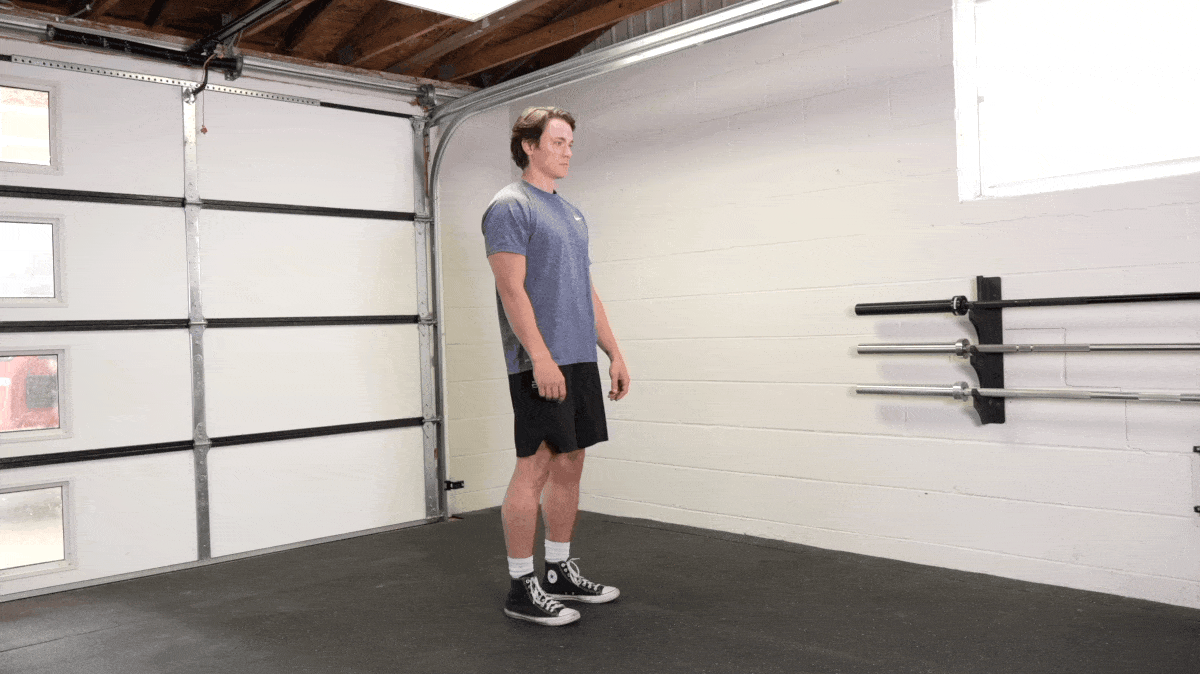
You may shudder at the word, but the burpee is the ultimate calorie burner. With several variations, the burpee can be great for beginners or challenge the fittest of athletes. This full-body bodyweight exercise can be seen in gyms almost everywhere and is popular in the CrossFit Games because this high-intensity movement allows you to do more work in less time.
[Read More: Does Cardio Burn Fat? The Anatomy of a Fitness Myth]
Not only do burpees burn a ton of calories while performing them, but they’re also great at stimulating excess post-exercise oxygen consumption (EPOC), meaning you’re burning more calories for the rest of the day. (1)
How To Do It
- Stand straight up with your feet shoulder-width apart and your eyes forward.
- Squat down with your chest up.
- Drop your hands to the ground and quickly snap your feet behind you, so you are in a plank position.
- Lower your chest to the floor like you would during a push-up and press back up.
- Snap your feet back to your squat position and lift your hands off the ground.
- Stand back up and jump, raising your arms overhead.
Modifications
- Make It Easier: Skip the jumping part and just come to a standing position.
- Make It Harder: Wear a weighted vest or hold two light dumbbells.
9. Triceps Dip
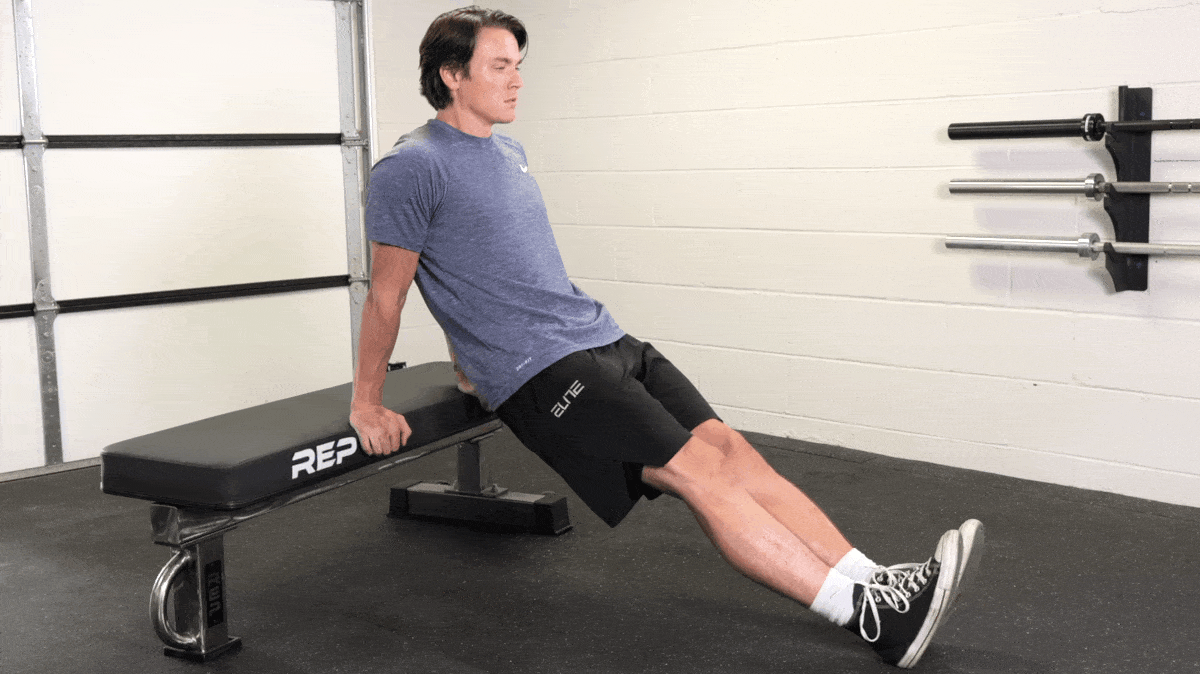
If you want to do bodyweight exercises at home to build your upper body strength, the dip is one of your best options. Working with proper dip bars is preferable, but you can certainly do this move in the comfort of your own home and strengthen your arms and shoulders in the process.
How To Do It
- Sit on the edge of an elevated surface like a chair or a bench and put your palms on the edge, fingers facing forward.
- Extend your legs in front of you so your heels are on the ground.
- Press through your palms and lift your body to hover above the ground.
- Slowly drop your torso while bending your elbows until you reach the end of your range of motion. Push yourself back up until your arms are extended.
Modifications
- Make It Easier: Perform chair dips if you aren’t ready to suspend your whole body weight.
- Make It Harder: Pause at the bottom or hold a small dumbbell between your ankles.
10. Pull-Up
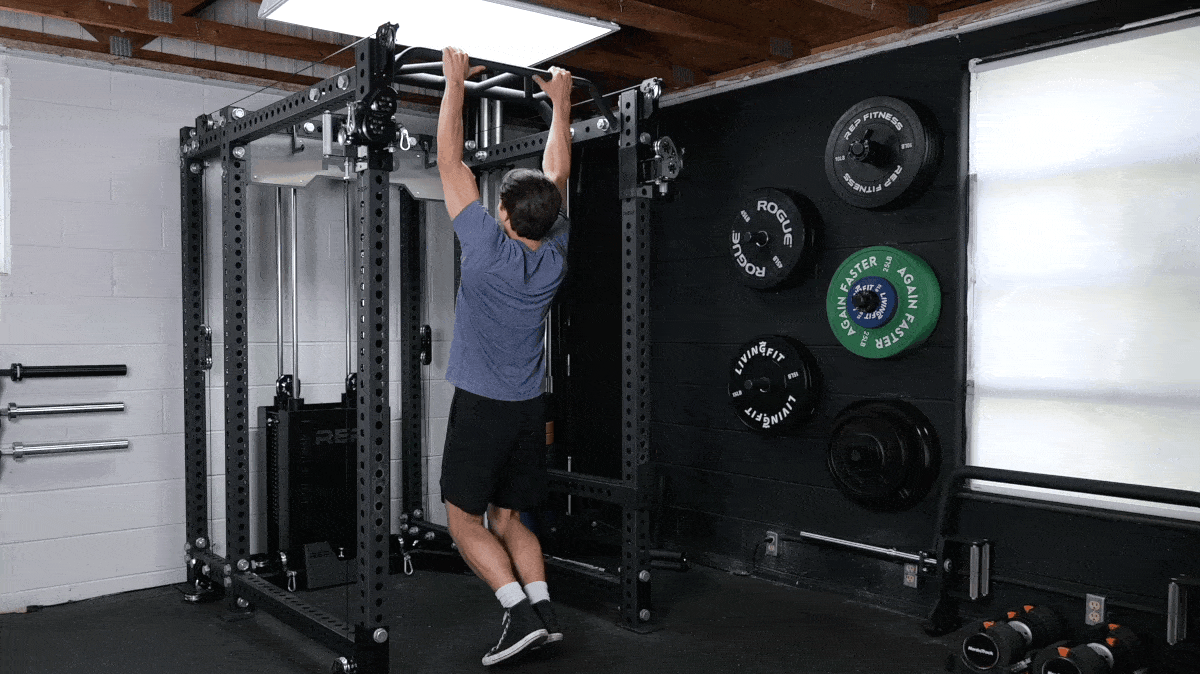
The pull-up is one of the harder bodyweight exercises you can do because of the required upper body strength. Even though this exercise targets a big muscle like the lats, weak arms, and shoulders can seriously debilitate your ability to perform even one rep. Plenty of progressions are available to master the pull-up, making it possible for anyone to get their game up.
Performing a compound exercise allows you to get more bang for your buck. Studies suggest compound exercises may benefit your VO2 max and general fitness more than isolation moves. (2) You can also expect the pull-up to improve your overall upper body strength, contributing to better lifts, stability, and posture.
How To Do It
- Find a pull-up bar that is high enough so that your feet don’t touch the ground when you hang on it.
- Grab the bar with an overhand grip slightly wider than shoulder-width apart.
- Pull your shoulders down and away from your ears to engage your lats.
- Squeeze your core and use your back, arms, and shoulders to pull your body up until the bar is at chest level.
Modifications
- Make It Easier: Try doing pull-up negatives until you can get your first rep.
- Make It Harder: Try a wide-grip pull-up.
11. Plank
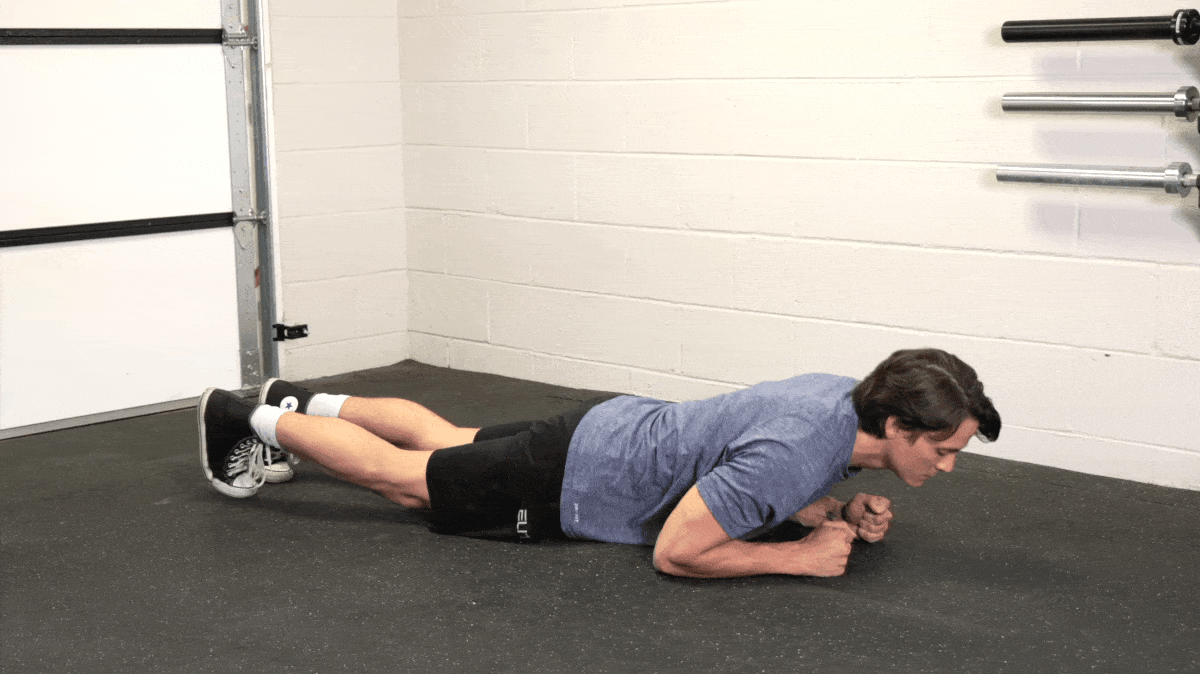
One of the more popular core exercises is the plank, but it doesn’t only work the core. Holding a plank can also target other major muscle groups in your body. If done properly, the plank can produce many benefits, including improved strength, stability, and posture in the trunk and hips.
Benefits of the plank include a stronger core and more protected spine (as well as better posture). It goes without saying but a strong core is absolutely essential for compound exercises as well. The plank also has some logistical perks, since you can perform them basically anywhere regardless of your experience level.
How To Do It
- Lie prone on the floor.
- With your elbows bent, raise yourself off the ground such that you’re suspended by your forearms and feet only.
- Squeeze your shoulder blades, tuck your hips slightly, and lock your knees out.
- There should be a straight line from the base of your neck to your ankles. Hold for time.
Modifications
- Make It Easier: Try planking with your knees on the floor.
- Make It Harder: Try slowly lifting one of your feet off the floor and alternating while you plank.
12. Wall Walk
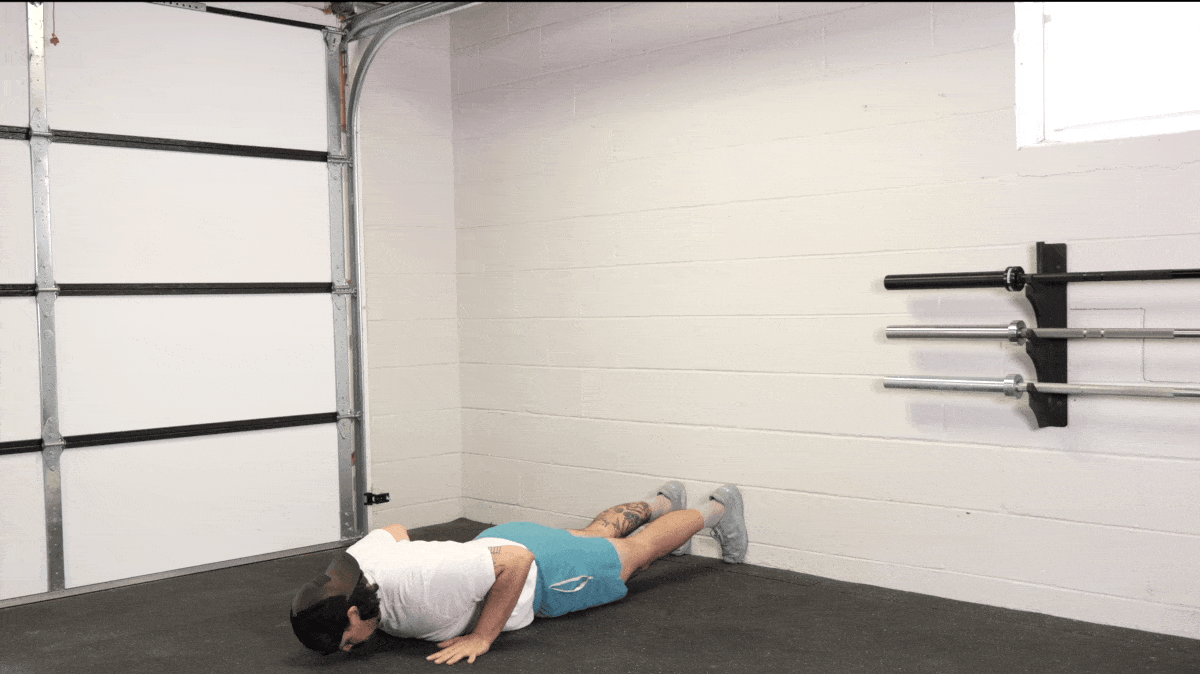
Climbing up walls isn’t just for Spider-Man. Wall walks recruit your back, arms, shoulders, and core and can help improve balance and stability. Often seen in CrossFit gyms and at the Games, wall walks are a high-intensity way to build strength and get your heart rate up. Performing wall walks can expose and remedy weaknesses in your movement integrity, especially in the core or shoulder.
[Read More: The Best Ab Exercises, Plus Ab Workout Routines]
The wall plank is great for developing general upper body strength, and you can also use them as a progression pathway toward more complex drills like handstands, handstand walks and push-ups.
How To Do It
- Lie on your stomach with your hands close to your sides and feet touching the wall behind you.
- Press your body off the ground and climb your feet up the wall by stepping one foot at a time.
- “Walk” all the way until your arms are fully extended and your belly button is as close to the wall as possible.
- Walk back down the same way you came.
Modifications
- Make It Easier: Try walking only halfway up the wall rather than moving into a full handstand.
- Make It Harder: Add a handstand push-up at the end of each rep.
13. Broad Jump
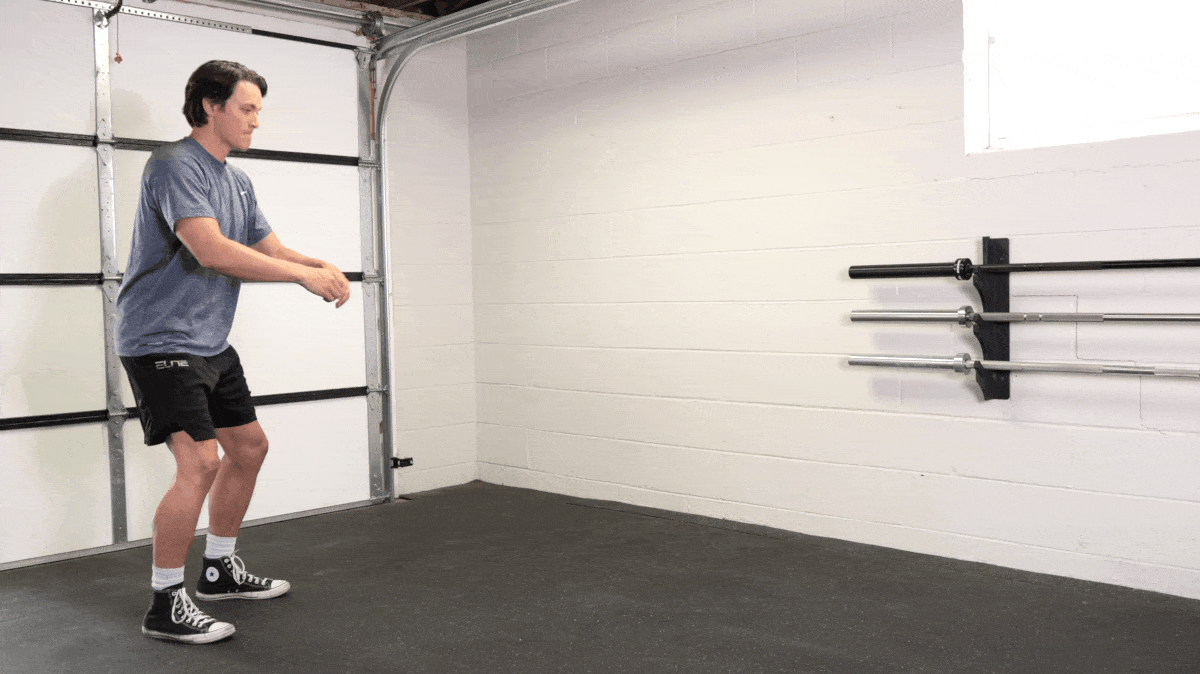
Plyometric training can produce benefits pertaining to physical fitness, overall health, and muscle strength. Research suggests that regular plyometrics can positively affect agility, speed, jumping, and overall performance. (3) Broad jumps involve jumping and absorbing force, increasing your heart rate and teaching your body how to land properly and effectively.
Explosive exercises like the broad jump also recruit fast-twitch muscle fibers, which are used for sprinting, jumping, and other short explosive movements. Studies suggest these muscles are more responsible for producing more power and may aid in heavy lifting. (4)
How To Do It
- Start with your feet shoulder-width apart.
- Push your hips back while loading the weight in your heels and swing your arms back to help prime for forward momentum.
- Drive your hips forward as your feet leave the ground and jump as far forward as you can.
- Land with a soft bend in your knees and absorb the weight in your heels.
Modifications
- Make It Easier: Start with vertical jumps.
- Make It Harder: Pause in the “loading position” before jumping.
14. Lunge
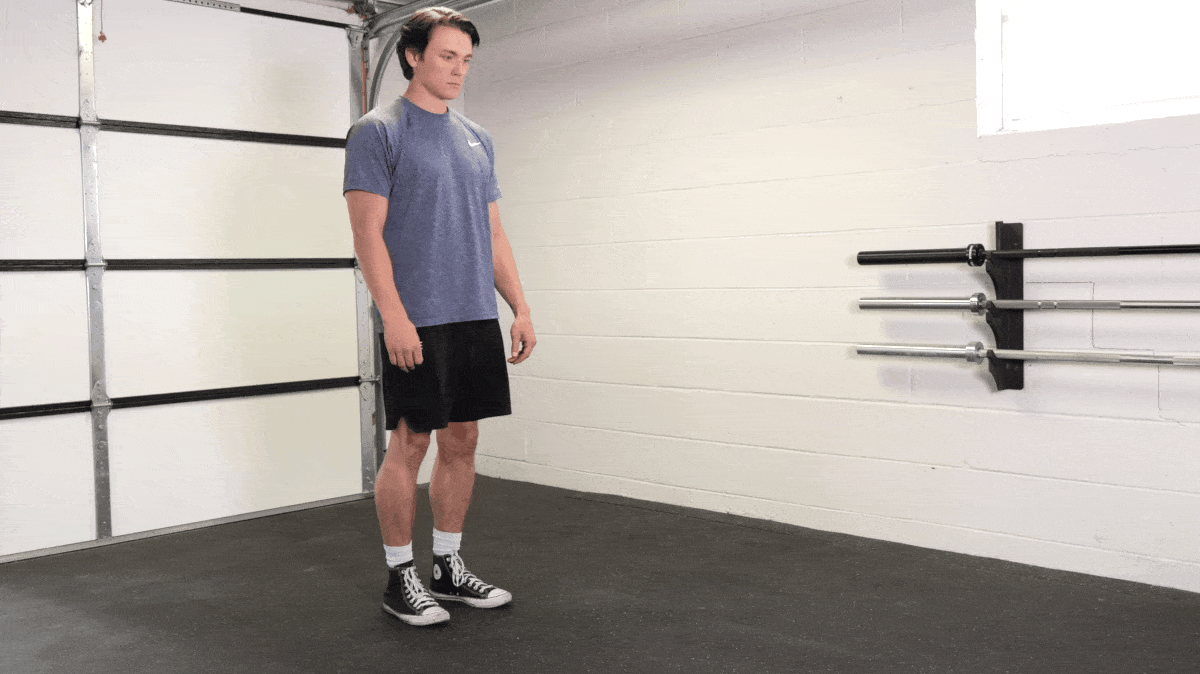
The lunge may get less love than the squat, but it is an effective way to target the legs and glutes. This unilateral exercise can improve your balance and stability and requires core activation. With plenty of different lunge variations —walking, forward, reverse, lateral, curtsy, and jumping — you can recruit other muscles, improve function, and add more variety to your workout.
[Read More: 5 Lunge Benefits For More Muscle and Improved Movement]
The lunge helps develop better balance and coordination, which translate into everyday activities. Lunges also provide some great glute stimulation, even without weights. Finally, unilateral exercises like the lunge can help improve muscle imbalances.
How To Do It
- Stand with your feet hip width apart — this will help you keep a strong and stable base when you step.
- Keep your chest up and core tight as you step straight forward, bending both knees to 90 degrees or to your range of motion.
- Press through the heel you stepped with to reset in your starting position.
Modifications
- Make It Easier: Try stationary lunges, holding on to a supportive surface if necessary.
- Make It Harder: Pause at the bottom of each rep.
15. Step-Up
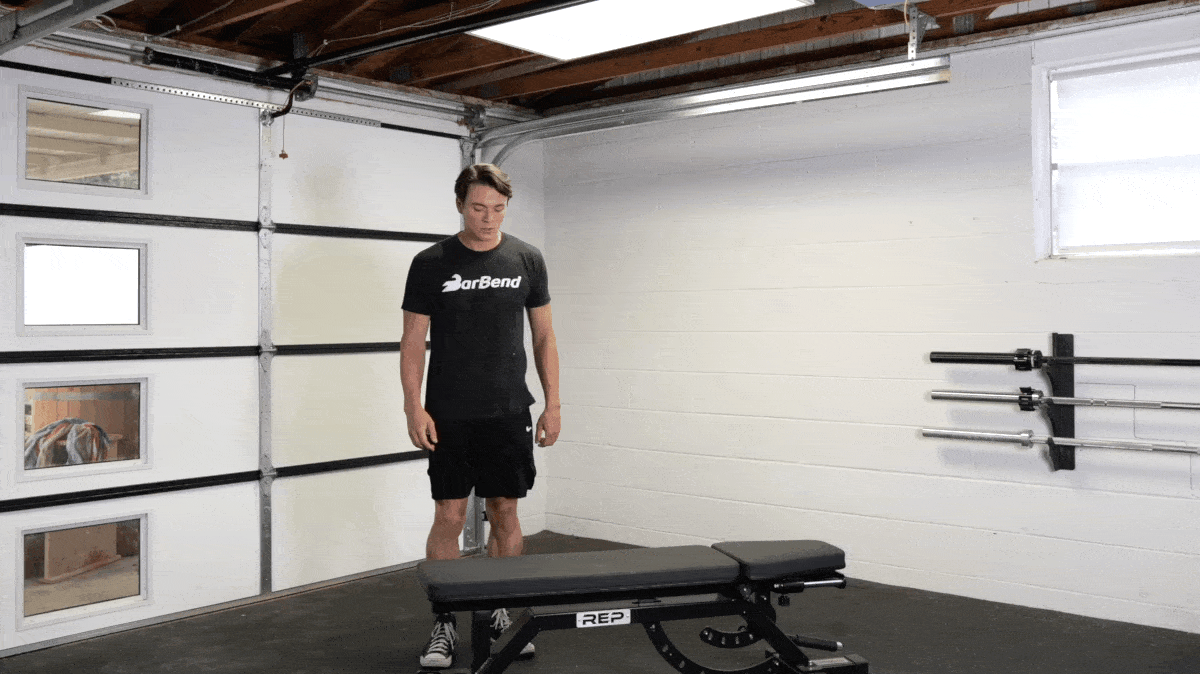
The step-up might seem self-explanatory, but don’t let the simplicity of this exercise fool you. It requires strength and balance and is easily modifiable to accommodate any fitness level. The step-up recruits the muscles in the lower body responsible for walking, running, bending your knees, hinging at your hips, and squatting. Doing this exercise regularly can help improve your lifts and your life.
[Read More: The Seven Biggest Benefits of Unilateral Training]
The step-up recruits some of the same muscle used to squat and deadlift, so it can improve these lifts. Unilateral exercises can also promote balance and stability and improve muscle imbalances.
How To Do It
- Stand in front of a stable surface like a bench or a box.
- Place your working leg on the elevated surface, brace your core, and push yourself up.
Modifications
- Make It Easier: Start with a low, 8 to 12-inch surface.
- Make It Harder: Hold a dumbbell in each hand or wear a weight vest.
Our 3 Favorite Bodyweight Workouts
An expert-crafted list of full-body bodyweight exercises is all well and good, but what are you supposed to do with this knowledge? You design bodyweight workouts, of course. Don’t worry, we’ve got you covered on that front. Here are a few of our favorite workouts you won’t need any fancy equipment to perform:
Lower-Body Bodyweight Workout
Lower-body workouts are hard; doubly so if you don’t have access to a gym full of machines, cables, or free weights. But don’t fret, you can still strengthen your legs with just your bodyweight. Try this workout on for size.
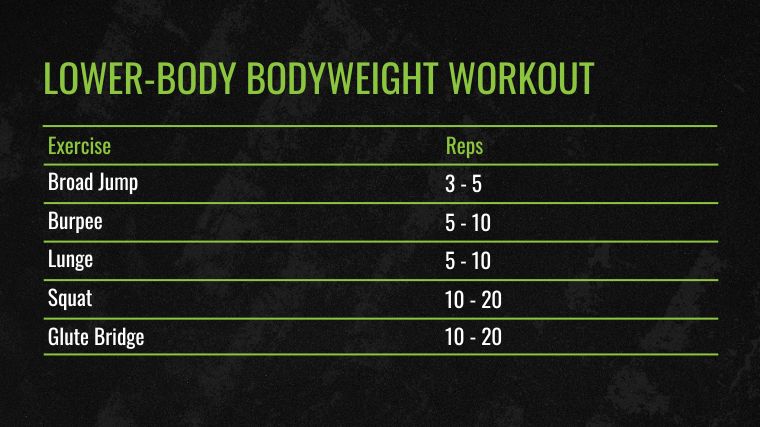
- Broad Jump: 3-5 reps
- Burpee: 5-10 reps
- Lunge: 5-10 reps
- Squat: 10-20 reps
- Glute Bridge: 10-20 reps
Perform this workout as a circuit, moving from one exercise to the next with little to no rest. Completing all five exercises counts as one round. Rest three to five minutes and perform up to 4 additional rounds.
Upper-Body Bodyweight Workout
Want to add muscle to your upper body without getting too bulky? Or are you simply sick of the weight room and want a fresh spin on your upper-body workout routine? In either case, give this workout a spin.

[Read More: The Best Upper Body Exercises and Workout Routines]
- Push-Up: 3 x 15-20
- Inverted Row: 3 x 12-15
- Triceps Dip: 3 x 12-15
- Chin-Up: 3 sets to failure
Full-Body Bodyweight Workout
Calisthenics are actually one of the best ways to perform full-body training sessions. Working with your own weight tends to require the use of more muscles than you’d get from a barbell or dumbbell exercise. Here’s our go-to full-body bodyweight workout routine:
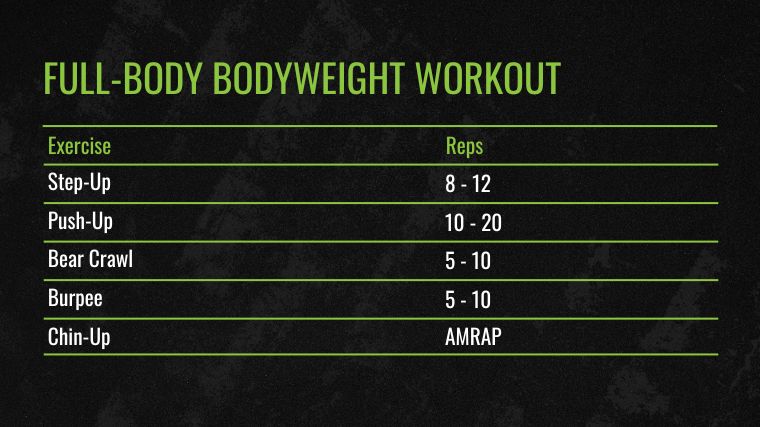
[Read More: How to do 100 Push-ups a Day, Advice and Programming from a CPT]
- Step-Up: 8-12 reps
- Push-Up: 10-20 reps
- Bear Crawl: 5-10 paces
- Burpee: 5-10 reps
- Chin-Up: AMRAP
Perform these exercises as a circuit, moving from one to the other with little to no rest.
How To Train With Bodyweight Exercises
With weights, you progress by lifting more absolute load or the same amount of weight for more reps. You don’t have that option for bodyweight movements, so you’ll have to rely on additional volume above all. Start by finding how many reps you can do of a bodyweight exercise before your form really breaks down.
Exercise Selection
Don’t try to perform 15 different bodyweight movements per day. The rules of exercise selection are the same; cluster movements together to double down on muscular stimulation, or pick one for each body part to train yourself from head to toe. For example, a lower-body calisthenics day could contain squats, walking lunges, and box jumps.
Sets and Reps
Once you’ve established your limit, perform multiple sets of 3 – 5 reps shy of that limit. If you can do 12 pull-ups, hit three sets of eight.
[Read More: The Most Effective Workout Splits, Created by Our Experts]
Each week, or workout session, add one to two reps to each set. Once you reach your max reps for all three sets, drop the rep count back to your starting number and add a set. You can also alter the tempo of each movement to make the reps more challenging.
Benefits of Bodyweight Exercises
There’s a lot of upside to training with nothing but your own body. Here, we’ll breakdown all of the pros of utilizing the moves above, from the positive effects they have on your movement to the fact that they require nearly zero equipment.
Easy and Accessible
You might want a exercise mat to protect your knees or elbows, but other than that, bodyweight training requires basically no equipment. No matter where you are, you can always bust out a circuit of push-ups, squats, and glute bridges.
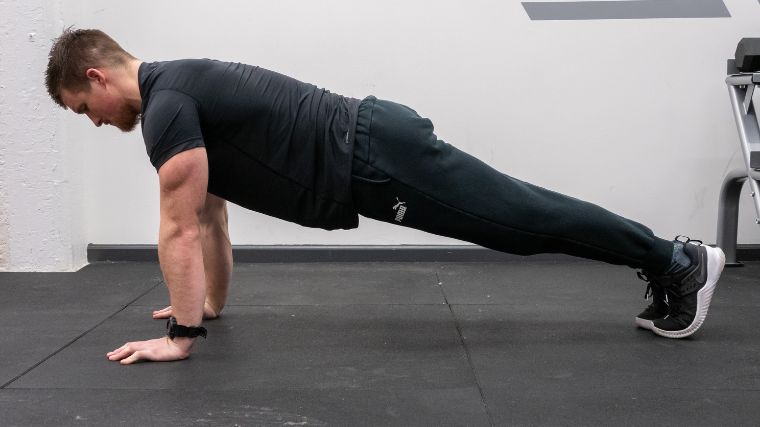
You can also get creative with how you structure a bodyweight workout at home. Try this deck of cards workout:
- Assign one move to a suit — so push-ups for spades, squats for clubs, burpees for diamonds, and inverted rows for hearts.
- Draw a card and perform the move associated with that suit for the number of reps on the card; or 11 reps for face cards and 15 for aces.
- Aim to rest as little as possible. If you’re a bit rusty, cut the deck in half.
Improved Mobility
Most bodyweight moves mimic everyday life. You squat to get out of a chair; you lunge when you walk up the stairs; you technically perform a pull-up when closing the garage door. Most movement patterns can be broken down into six basic categories — a vertical pull, vertical push, horizontal pull, horizontal push, knee-based movement, and a hip-based movement. Here’s an example of each:
[Read More: The Best Mobility Exercises From a Physical Therapist (+ Tips)]
By performing bodyweight exercises, you’re improving your proficiency in these patterns and making yourself stronger in these positions. Barbell work accomplishes this as well, of course, but with the obvious caveat that you must have access to weights in the first place.
Unparalleled Convenience
Unlike powerlifters or strongman competitors who need specialized equipment for their training, bodyweight aficionados can go hard just about anywhere. Since you’re forgoing the barbell for your own body weight, calisthenics-based routines can be performed wherever you have enough physical space.
This makes bodyweight training convenient in a way that other activities can’t match. If you spend a lot of time traveling or don’t have access to a commercial gym, a good bodyweight routine can help you stay strong and gain muscle.
Scalable for All Levels
You may think that squatting or doing a push-up with your bodyweight is the ground floor for all exercise, but that’s not the case. A true beginner can squat to a chair, hang from a pull-up bar to build their base, or elevate their hands for push-ups on the edge of a couch.
And when you eventually outgrow the basic variations above, there are ways to make bodyweight moves harder. Push-ups can be performed with one arm, squats can be turned into 1-½-rep squats, and you can elevate your legs for inverted rows.
Frequently Asked Questions
Can bodyweight exercises build muscle?
Yes! Bodyweight training is perfectly effective at growing muscle, particularly for beginners. However, bear in mind that you will eventually adjust to the demand of stabilizing your own weight, and eventually most bodyweight moves become too easy to encourage new muscle growth. When that day comes, you’ll need to adjust by performing more repetitions or trying a harder variation.
Can I do just bodyweight exercises?
It depends on your goals. Bodyweight-only training is a convenient way of maintaining a regular exercise routine and can also help you stay limber and flexible. However, if you want to prioritize gaining strength or muscle, you’ll need to use other equipment at least some of the time.
What are the cons of bodyweight exercises?
Calisthenics training is great, but it isn’t the end-all, be-all of fitness. Most bodyweight workouts suffer from an uneven difficulty curve — a regular push-up might be too easy for you, but a single-armed push-up is much, much more difficult. It’s hard to find a middle ground there.
Bodyweight moves are also clumsy to progress. Sure, you can add more weight or work for longer durations, but you can’t do that forever. Nor would it be an efficient use of your time.
References
- Podstawski, Robert, Markowski, Piotr, & Clark, Cain C. T. International Standards for the 3‐Minute Burpee Test: High‐ Intensity Motor Performance. Journal of Human Kinetics. 2019; 69 doi: 10.2478/hukin-2019-0021
- Paoli, Antonio, Gentil, Paulo, & Moro, Tatiana. Resistance Training with Single vs. Multi-joint Exercises at Equal Total Load Volume: Effects on Body Composition, Cardiorespiratory Fitness, and Muscle Strength. Frontiers in Physiology. 2017;8 doi: 10.3389/fphys.2017.01105
- Slimani, Maamer, Chamari, Karim, & Miarka, Bianca. Effects of Plyometric Training on Physical Fitness in Team Sport Athletes: A Systematic Review. Journal of Human Kinetics. 2016; 53. doi: 10.1515/hukin-2016-0026
- Karp, Jason R. MS. Muscle Fiber Types and Training. Strength and Conditioning Journal. 2001; 23(5).
Featured Image: LarsZ / Shutterstock
The post The 15 Best Bodyweight Exercises, + Workouts and Tips From a CPT appeared first on BarBend.

